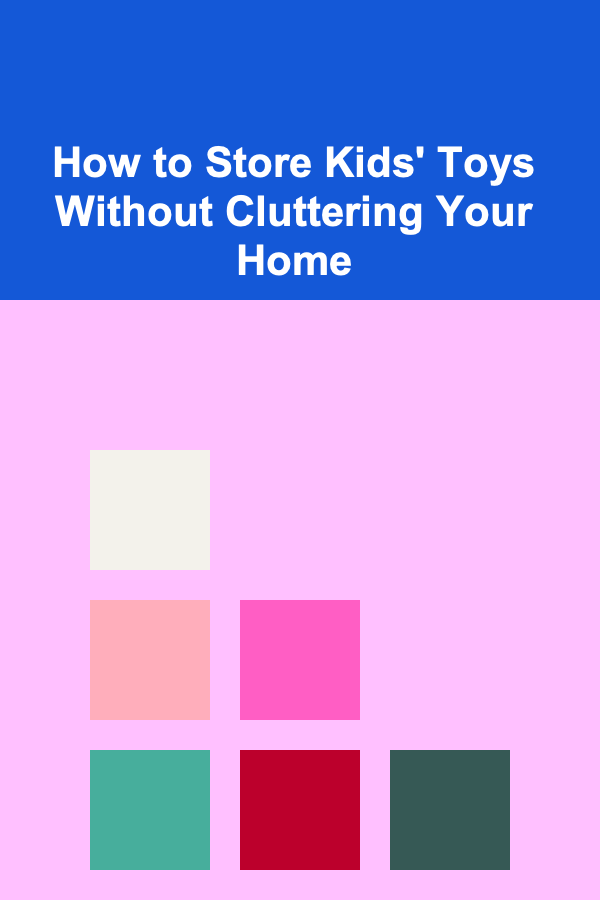
How to Store Kids' Toys Without Cluttering Your Home
ebook include PDF & Audio bundle (Micro Guide)
$12.99$10.99
Limited Time Offer! Order within the next:

As any parent knows, kids' toys can quickly take over a home. From plush animals to action figures, building blocks, and puzzles, it feels like toys multiply faster than you can clean them up. While the toys provide valuable learning and fun for children, they also create a massive organizational challenge. Maintaining a tidy, clutter-free home becomes increasingly difficult as the toy collection grows, and it can be overwhelming to find effective storage solutions that keep both kids and parents happy.
The key to managing toys without sacrificing the aesthetic appeal or functionality of your home is establishing smart and sustainable storage solutions. In this article, we'll explore various ways to store kids' toys, helping you to maintain an organized, clutter-free home while making sure your children have easy access to their favorite toys. From innovative storage ideas to efficient organization systems, there are countless ways to store toys in a manner that maximizes space and minimizes mess.
The Importance of Toy Organization
Before diving into specific storage solutions, it's essential to understand why toy organization is so important. Kids' toys aren't just scattered around the house; they represent creativity, growth, and the development of essential skills like problem-solving, coordination, and social interaction. However, too many toys in an unorganized state can lead to frustration, stress, and a chaotic environment for both children and parents.
There are several benefits to keeping toys organized:
- Reduced Clutter: An organized space leads to a cleaner and more peaceful environment, helping you avoid the overwhelming mess that so often accumulates.
- Promotes Independence: When toys are organized, children can learn to take responsibility for their belongings and develop important skills such as tidying up and categorizing.
- Stimulates Play: A well-organized toy collection encourages creative play. When toys are easy to find, kids can engage more easily and meaningfully with their toys, rather than spending time searching for them.
- Prevents Damage: Proper storage helps prevent toys from becoming damaged, broken, or lost by keeping them in designated places.
- Less Stress for Parents: Organizing toys can reduce the stress and frustration of constantly having to deal with clutter, leaving more room for relaxation and enjoyment of family time.
Now that we understand the importance of organizing kids' toys, let's dive into some creative and effective ways to store them.
Categorize Toys
One of the most important first steps in organizing kids' toys is categorization. Sorting toys into categories based on type, size, or use will help you make sense of the sheer volume and complexity of toys your kids have.
Common Toy Categories:
- Building Toys: Legos, building blocks, and other construction sets.
- Action Figures & Dolls: Superheroes, dolls, and figurines.
- Arts and Crafts Supplies: Markers, crayons, paints, and other craft materials.
- Stuffed Animals: Plush toys of all shapes and sizes.
- Games & Puzzles: Board games, card games, and jigsaw puzzles.
- Outdoor Toys: Balls, jump ropes, and other outdoor play items.
- Books and Educational Toys: Books, puzzles, and educational games.
By grouping similar toys together, you can better organize your storage options and prevent smaller toys from getting lost among larger ones. Categorization also helps kids understand where their toys go, making it easier for them to clean up after playtime.
Invest in Storage Bins and Baskets
Storage bins and baskets are essential components of any toy storage system. They are an easy and affordable way to contain toys and maintain a clean and organized space. Bins come in a variety of sizes, colors, and styles to fit the aesthetic of any home, and they can be easily labeled for even more organization.
Tips for Using Bins and Baskets:
- Label the Bins: Labeling bins by category or toy type helps both parents and children know exactly where toys belong. You can use stickers, images, or color-coding to make it easier for kids to sort their toys.
- Stackable Bins: Stackable bins are great for maximizing vertical space. These bins can be stacked on top of each other, allowing you to store multiple categories in one area without taking up too much floor space.
- Transparent Bins: Transparent bins allow you to see the contents without opening them, making it easier to locate specific toys.
- Baskets for Soft Toys: Use fabric baskets or wicker baskets to store plush toys. These baskets look stylish and can be placed in various locations throughout the house.
Storage bins are versatile enough to store a range of toys, and they can be tucked away in closets, under beds, or on shelves, depending on your available space.
Under-Bed Storage
Under-bed storage is an excellent solution for toys that aren't used daily but still need to be easily accessible. Many kids' toys, such as larger building sets or seasonal items, can be neatly stored under the bed in bins or rolling carts.
Benefits of Under-Bed Storage:
- Maximize Space: Under-bed storage utilizes an area that would otherwise go unused, freeing up space elsewhere in the room.
- Keeps Toys Out of Sight: By storing toys under the bed, they remain out of sight and out of mind, helping to maintain a clean, organized appearance.
- Easy Access: Rolling bins or drawers under the bed can be easily pulled out, giving kids access to their toys without cluttering the rest of the room.
Consider using rolling storage bins or pull-out drawers, as these are easy for kids to access on their own and help keep toys neatly organized.
Toy Storage Furniture
Toy storage furniture is an excellent option if you want to maintain the decor of your home while still keeping your child's toys organized. These pieces of furniture are designed to store toys without compromising on style. Toy storage units can double as furniture pieces, such as benches, tables, or cabinets, offering a multi-functional solution for your home.
Types of Toy Storage Furniture:
- Toy Storage Benches: These benches provide a place to sit while also offering hidden storage underneath. They're perfect for storing stuffed animals, puzzles, or even art supplies.
- Storage Cubes and Shelves: Open storage cubes or shelves can house various bins, baskets, and containers, making it easy to store and access toys. Additionally, shelves can display books or collectibles while keeping the space organized.
- Cabinets and Closets: A small cabinet or cupboard can be a great way to keep toys out of sight. Consider a unit with several compartments, so you can separate toys into categories.
By choosing pieces that blend with the room's decor, toy storage furniture helps keep toys out of sight while maintaining a stylish, organized environment.
Use Vertical Space
When dealing with limited floor space, maximizing vertical storage is crucial. Vertical space can be utilized with wall-mounted shelves, pegboards, or hanging storage systems to store toys off the ground.
Ideas for Using Vertical Space:
- Wall-Mounted Shelves: Install shelves at child-friendly heights to store toys and books. You can use small bins or baskets on the shelves to keep smaller toys organized.
- Pegboards: A pegboard is a versatile and customizable storage solution for hanging items like dolls, action figures, and art supplies.
- Over-the-Door Organizers: Over-the-door pockets or racks can store smaller toys, shoes, or craft supplies while keeping them easily accessible.
By using the vertical space in your home, you can keep the floor area free for play and create a more spacious environment.
Toy Rotation System
A toy rotation system is an effective way to keep kids' toys fresh and exciting without overwhelming them with an excess of options. This involves periodically swapping out the toys your child has access to, while storing the rest out of sight.
How to Implement a Toy Rotation System:
- Categorize and Separate: Sort your child's toys into categories, then rotate them based on interest or use. For example, you could have a set of toys for indoor play, another for outdoor play, and another set for educational activities.
- Store Extras: Store the toys that aren't being used in bins or boxes and swap them out every few weeks. This helps reduce the number of toys available at any given time, making the room feel less cluttered and more manageable.
- Keep Things Interesting: Children can become bored with the same toys, but a rotation system ensures that they always have something new and exciting to play with.
Toy rotation systems can also teach children about the value of keeping their toys organized, as they are encouraged to take care of and appreciate each item they receive.
Label Everything
Labeling toys is an essential part of toy organization, especially as children begin to take on the responsibility of cleaning up. Labels can be simple or creative, and they help children identify where their toys belong. Using clear labels ensures that toys are returned to their proper place after use, which encourages tidy habits.
Labeling Ideas:
- Image Labels: Use pictures of the toys or categories of toys, so younger children can understand where each item goes.
- Color-Coded Labels: Color-coding bins or baskets can also be a fun way for kids to sort their toys.
- DIY Labels: You can make your own labels by printing them out or using washable markers. Get your child involved in the labeling process to make it a fun activity.
Labeling helps prevent the chaos that comes with toys being scattered everywhere and creates a system that's easy for both kids and parents to follow.
Conclusion
Storing kids' toys without cluttering your home requires a combination of creativity, organization, and consistency. By categorizing toys, using storage bins, and implementing clever solutions like toy rotation and vertical storage, you can maintain a neat and organized environment. Ultimately, the goal is to make the process of cleaning up enjoyable for both you and your child. With a bit of planning and organization, you can create a space that is both functional and aesthetically pleasing, allowing your kids to enjoy their toys while ensuring your home remains a peaceful sanctuary.

How to Extend the Life of Your Home's Furniture and Fixtures
Read More
How to Organize a Sewing Room for Multiple Users
Read More
How to Organize and Clean Your Closet for Maximum Space
Read More
How to Store Your Holiday Decorations Without Clutter
Read More
The Ultimate Guide to Secondhand Shopping: Tips for Scoring the Best Deals
Read More
How to Optimize Your Social Media To-Do List for Engagement
Read MoreOther Products

How to Extend the Life of Your Home's Furniture and Fixtures
Read More
How to Organize a Sewing Room for Multiple Users
Read More
How to Organize and Clean Your Closet for Maximum Space
Read More
How to Store Your Holiday Decorations Without Clutter
Read More
The Ultimate Guide to Secondhand Shopping: Tips for Scoring the Best Deals
Read More